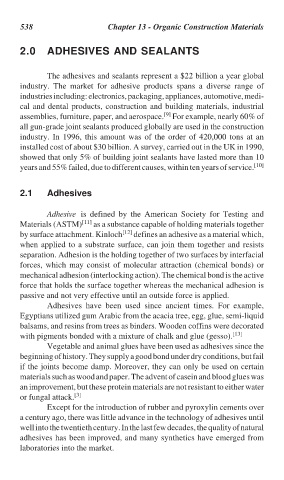Page 568 - Handbook of Thermal Analysis of Construction Materials
P. 568
538 Chapter 13 - Organic Construction Materials
2.0 ADHESIVES AND SEALANTS
The adhesives and sealants represent a $22 billion a year global
industry. The market for adhesive products spans a diverse range of
industries including: electronics, packaging, appliances, automotive, medi-
cal and dental products, construction and building materials, industrial
[9]
assemblies, furniture, paper, and aerospace. For example, nearly 60% of
all gun-grade joint sealants produced globally are used in the construction
industry. In 1996, this amount was of the order of 420,000 tons at an
installed cost of about $30 billion. A survey, carried out in the UK in 1990,
showed that only 5% of building joint sealants have lasted more than 10
years and 55% failed, due to different causes, within ten years of service. [10]
2.1 Adhesives
Adhesive is defined by the American Society for Testing and
Materials (ASTM) [11] as a substance capable of holding materials together
by surface attachment. Kinloch [12] defines an adhesive as a material which,
when applied to a substrate surface, can join them together and resists
separation. Adhesion is the holding together of two surfaces by interfacial
forces, which may consist of molecular attraction (chemical bonds) or
mechanical adhesion (interlocking action). The chemical bond is the active
force that holds the surface together whereas the mechanical adhesion is
passive and not very effective until an outside force is applied.
Adhesives have been used since ancient times. For example,
Egyptians utilized gum Arabic from the acacia tree, egg, glue, semi-liquid
balsams, and resins from trees as binders. Wooden coffins were decorated
with pigments bonded with a mixture of chalk and glue (gesso). [13]
Vegetable and animal glues have been used as adhesives since the
beginning of history. They supply a good bond under dry conditions, but fail
if the joints become damp. Moreover, they can only be used on certain
materials such as wood and paper. The advent of casein and blood glues was
an improvement, but these protein materials are not resistant to either water
or fungal attack. [3]
Except for the introduction of rubber and pyroxylin cements over
a century ago, there was little advance in the technology of adhesives until
well into the twentieth century. In the last few decades, the quality of natural
adhesives has been improved, and many synthetics have emerged from
laboratories into the market.

